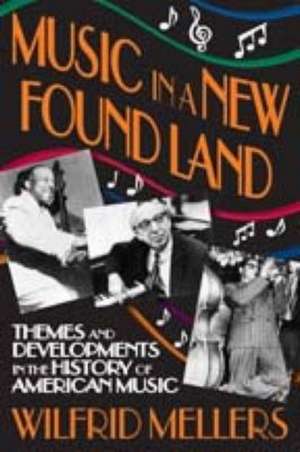Music in a New Found Land: Themes and Developments in the History of American Music
Autor Wilfrid Mellersen Limba Engleză Paperback – 15 ian 2011
It has always been difficult to separate American music from its immediate relevance to the twentieth century. Mellers' theme involves the relationship between "art" music, jazz and pop music; he sees the segregation of these genres as both illogical and artifi cial. If the pop music of Tin Pan Alley may be anti-art, it has also produced Gershwin, Ellington, and composing improvisers such as Louis Armstrong, Charlie Parker, and Miles Davis.
The study of American music is as relevant into any inquiry into a national culture as the study of American literature and painting. This book contains a large number of quotations from American writers, because Mellers thought American sensibility should parallel, reinforce, and comment on American music. In sum, this is the closest available one-volume history of American music, and a window into American culture.
Preț: 332.47 lei
Preț vechi: 382.85 lei
-13% Nou
Puncte Express: 499
Preț estimativ în valută:
63.62€ • 69.32$ • 53.61£
63.62€ • 69.32$ • 53.61£
Carte tipărită la comandă
Livrare economică 23 aprilie-07 mai
Preluare comenzi: 021 569.72.76
Specificații
ISBN-13: 9781412809962
ISBN-10: 1412809967
Pagini: 590
Dimensiuni: 152 x 229 x 34 mm
Greutate: 0.79 kg
Ediția:1
Editura: Taylor & Francis
Colecția Routledge
Locul publicării:Oxford, United Kingdom
ISBN-10: 1412809967
Pagini: 590
Dimensiuni: 152 x 229 x 34 mm
Greutate: 0.79 kg
Ediția:1
Editura: Taylor & Francis
Colecția Routledge
Locul publicării:Oxford, United Kingdom
Cuprins
One: The Pioneer and the Wilderness; I: A pre-history of American music: the primitives, the retreat to Europe and the conservative tradition; II: Realism and transcendentalism: Charles Ives as American hero; III: Men and mountains: Carl Ruggles as American mystic; Roy Harris as religious primitive; IV: Skyscraper and Prairie: Aaron Copland and the American isolation; V: The Pioneer’s energy and the Artist’s order: Elliott Carter; VI: The American frenzy and the unity of serialism: Wallingford Riegger and Roger Sessions; VII: The retreat from the west: science and magic: Charles Griffes, Henry Cowell and Edgard Varèse; VIII: From noise to silence: Harry Partch, John Cage and Morton Feldman; IX: Innocence and nostalgia: Samuel Barber and Virgil Thomson; X: Today and Tomorrow: Lukas Foss and the younger generation; Two: The world of art and the world of commerce: the folk-song of the asphalt jungle; I: Introductory: Music and entertainment in nineteenth-century America: Stephen Foster, Louis-Moreau Gottschalk and John Philip Sousa; II: Orgy and alienation: country blues, barrelhouse piano, and piano rag; III: Heterophony and improvisation: the New Orleans jazz band and King Oliver; Bessie Smith and the urban blues; IV: From heterophony to polyphony: from polyphony to the antiphony of the big band: improvisation and composition in the work of Louis Armstrong, Jelly Roll Morton and Count Basie; V: Jazz polyphony and jazz harmony: Duke Ellington as composer; VI: From art back to jazz. Modern jazz and the composing improviser: Thelonious Monk and Charlie Parker, Ornette Coleman and John Coltrane; VII: From jazz back to art. Modern jazz and the improvising composer: Miles Davis and Gil Evans; Gerry Mulligan and John Lewis; VIII: From jazz to pop: the decline of the big bands: pianists, cabaret singers and the “musical”; IX: From pop to art: opera, the musical and George Gershwin’s “Porgy and Bess”; X: From art to pop: Marc Blitzstein’s “Regina” and Leonard Bernstein’s “West Side Story”; the rebirth of wonder; Epilogue
Descriere
The subject of this book is accurately defined by its subtitle
